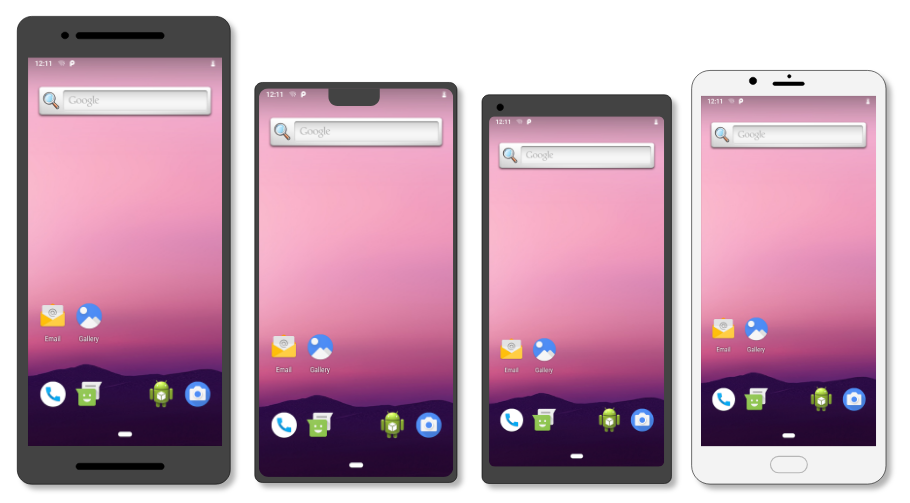Ein generisches Systemimage (GSI) ist eine reine Android-Implementierung mit unverändertem Code des Open-Source-Projekts für Android (Android Open Source Project, AOSP), die auf einer Vielzahl von Android-Geräten ausgeführt werden kann.
App-Entwickler können die neuesten Android-GSIs installieren und ausführen, um Apps auf einer Vielzahl vorhandener Android-Geräte zu testen. Dabei können sie GSIs aus verschiedenen Android-Betriebssystem-Releases verwenden, darunter Developer Preview- und Beta-Builds. Das Hinzufügen von GSIs zu Ihren Bestätigungs- und Testprozessen kann Ihnen einige zusätzliche Vorteile bieten:
- Größere Testabdeckung auf einer größeren Anzahl echter Geräte
- Mehr Zeit zum Beheben von Problemen mit der App-Kompatibilität
- Mehr Möglichkeiten, von App-Entwicklern gemeldete Kompatibilitätsprobleme in Android zu beheben
Das GSI-Projekt ist Open Source und trägt zur Verbesserung der Android-Plattform bei, indem es vor jeder Android-Version mehr Möglichkeiten bietet, die Qualität von Apps und Betriebssystemen zu verbessern.

GSIs enthalten dieselben Kernsystemfunktionen für alle Geräte, auf denen sie installiert sind. Eine GSI enthält also keine Anpassungen des Geräteherstellers. Daher kann es in den folgenden Situationen zu Verhaltensunterschieden kommen:
- Interaktionen, bei denen die Benutzeroberfläche verwendet wird
- Workflows, die neuere Hardwarefunktionen erfordern
Gerätekonformität prüfen
GSIs können nur auf Geräten mit den folgenden Eigenschaften ausgeführt werden:
- Der Bootloader ist entsperrt.
- Vollständig Treble-kompatibel.
- Bei Markteinführung mit Android 9 (API‑Level 28) oder höher. Geräte, die von einer früheren Version auf Android 9 aktualisiert wurden, unterstützen GSIs möglicherweise nicht.
So ermitteln Sie, ob Ihr Gerät ein GSI verwenden kann und welche GSI-Betriebssystemversion Sie installieren sollten:
Prüfen Sie mit dem folgenden Befehl, ob Treble unterstützt wird:
adb shell getprop ro.treble.enabled
Wenn die Antwort
falselautet, ist das Gerät nicht mit GSIs kompatibel und Sie sollten nicht fortfahren. Wenn die Antworttruelautet, fahre mit dem nächsten Schritt fort.Prüfen Sie mit dem folgenden Befehl, ob die Versionen kompatibel sind:
adb shell cat /system/etc/ld.config.version_identifier.txt \ | grep -A 20 "\[vendor\]"
Suchen Sie in der Ausgabe im Abschnitt
[vendor]nachnamespace.default.isolated.Wenn der Wert für dieses Attribut
trueist, unterstützt das Gerät das Vendor Native Development Kit (VNDK) vollständig und kann jede GSI-Betriebssystemversion verwenden, die neuer als die Betriebssystemversion auf dem Gerät ist. Verwenden Sie nach Möglichkeit die neueste verfügbare GSI-Betriebssystemversion.Wenn der Wert für das Attribut
falseist, ist das Gerät nicht vollständig VNDK-kompatibel und kann nur ein GSI für dieselbe On-Device-Betriebssystemversion verwenden. Auf einem Gerät mit Android 10 (API-Version 29), das nicht VNDK-kompatibel ist, kann beispielsweise nur ein Android 10-GSI-Image geladen werden.Der CPU-Architekturtyp des GSI muss mit der CPU-Architektur des Geräts übereinstimmen. Führen Sie den folgenden Befehl aus, um die richtige CPU-Architektur für das GSI-Image zu ermitteln:
adb shell getprop ro.product.cpu.abi
Anhand der Ausgabe können Sie ermitteln, welches GSI-Image Sie beim Flashen Ihres Geräts verwenden müssen. Auf einem Pixel 5 würde die Ausgabe beispielsweise angeben, dass die CPU-Architektur
arm64-v8aist. Sie würden also den GSI-Typarm64verwenden.
GSIs herunterladen
Je nach Ihren Entwicklungsanforderungen gibt es verschiedene Möglichkeiten, GSIs zu erhalten:
- Für Android-Preview-GSIs und Android-GSIs mit GMS laden Sie die Images von der GSI-Releaseseite herunter.
Wenn Sie vorgefertigte GSI-Images ohne GMS-Anwendungen verwenden möchten, laden Sie die Images von der AOSP CI-Website herunter:
Wenn Sie Android-GSIs ohne GMS erstellen möchten, laden Sie den Quellcode von AOSP herunter und erstellen Sie Ihre GSIs.
GSI installieren
Die Installation eines GSI ist geräteabhängig. Informationen zu den genauen Tools und Verfahren erhalten Sie vom Hersteller Ihres Geräts. Für Google Pixel-Geräte wie das Pixel 3 und neuere Modelle gibt es mehrere Installationsmöglichkeiten:
- Manuelles Flashen von GSI-Images: siehe Anforderungen für das Flashen von GSIs
- Verwenden von Dynamic System Update (DSU) für Geräte, auf denen bereits Android 10 oder höher ausgeführt wird: siehe die Seite Dynamic System Updates
Feedback geben
GSIs sollen Ihnen helfen, Ihre Apps auf Android zu validieren. Wir freuen uns über Ihr Feedback zu den Bildern, den Tools und dem Verfahren zur Verwendung von GSIs auf Ihren Geräten.
Wenn Sie uns Fehler melden oder Funktionsanfragen senden möchten, verwenden Sie die spezielle Komponente zur Problemverfolgung für GSIs.

